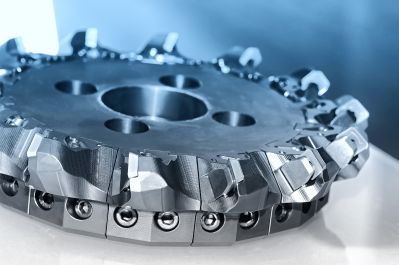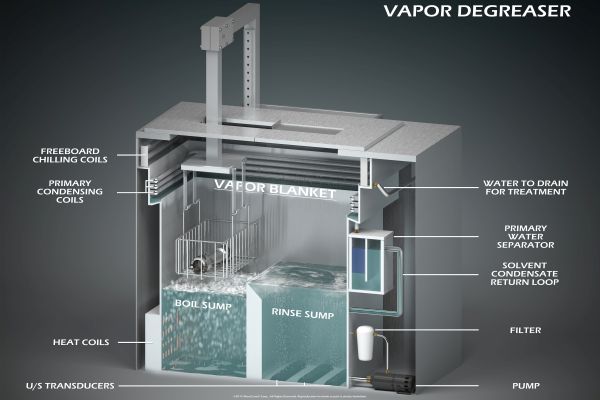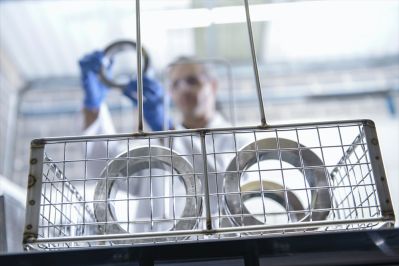Vapor Degreasing, the Finishing Touch
Decreasing cycle times, reducing machine downtime and increasing worker performance are the most obvious areas metal fabricators target for improvement. But according to Venesia Hurtubise, Technical Chemist at MicroCare, LLC, many fabricators are missing one area that can make a big impact on output -- cleaning.
Effective cleaning is an important step that often gets overlooked in the production process. Having a clean and properly prepped surface is essential to a superior finish. Cleaning ensures parts are ready for downline processes like painting, coating, plating and welding. Poorly prepped parts can reduce production, quality and parts reliability.
The Solution to an Improved Finish
Almost all metal parts are contaminated during production. Whether it is oil or grease, metal swarf, or cutting or polishing fluids, it must be removed for down-line processes to be successful.

Complex Part: Vapor degreasing removes contaminants from small complex geometries, intricate shapes, blind holes and through holes.
Vapor degreasing is one method that meets the cleaning challenge. It is a highly effective, quick and consistent way to critically clean metal parts. It easily removes contaminants from small complex geometries, intricate shapes, and difficult to clean features like blind holes and through holes. It also boasts high throughput and easily automates into standard production lines.
Just two elements are required for vapor degreasing, a closed-top vapor degreaser machine and a specialized low-boiling, non-flammable sustainable cleaning fluid. Most vapor degreasers contain a boil sump and a rinse sump. Metal parts are immersed into heated cleaning fluid in the boil sump. This thoroughly dissolves and lifts contaminant from the parts surface.
Parts are then mechanically transferred to the rinse sump. Here, components are rinsed in pure, uncontaminated fluid or inside the fluid vapors themselves. The cleaning fluid then condenses and drips back into the vapor degreaser to be reused. After a typical cleaning cycle of about 6-20 minutes, the parts come out dry, cool, spot-free and ready for processing or packaging.
Flexible Cleaning Fluids
What makes vapor degreasers particularly effective is the specialized cleaning fluid used within them. The cleaning fluids have multiple chemical properties that are beneficial to critical cleaning and surface preparation.

Vapor Degreaser: Just two elements are needed for vapor degreasing, a closed-top vapor degreaser machine and a specialized low-boiling, non-flammable sustainable cleaning fluid.
Modern vapor degreasing fluids typically have a low surface tension and a very low viscosity. This allows them to easily penetrate and clean inside compact and complex spaces like internal blind holes. Many of the fluids used with the vapor degreasers also are very heavy and dense, typically 20-40% heavier than water, which aids in dislodging particulate from the components.
After cleaning, the fluid quickly evaporates, leaving all components dry and residue-free, both inside and out. This enables workers to move on to the next production process sooner, improving the overall throughput and productivity.
Additionally, the fluid can be selected for specific cleaning challenges making it a flexible cleaning solution. For example, an azeotropic fluid, or mixture of two or more fluids, can be engineered to combine high solubility for cleaning very difficult-to-remove soils, such as heavy greases or waxes, with the benefits of nonflammability for safety and an environmental profile that does not contribute to poor air quality.
Meeting Safety Standards
Vapor degreasing meets the cleaning challenge with ease, but it also meets the many safety regulations and standards companies must follow. Modern cleaning fluids are not only nonflammable, helping to improve safety on the shop floor, but they can also have excellent toxicity ratings and exposure limits.
Toxicity rating is used to protect workers from dangerous exposures during their working life and can be identified in several ways. The most common is TLV (Threshold Limit Value). The TLV of a cleaning fluid is expressed in parts-per-million (ppm). The higher the number the safer it is, so anything near the highest rating of 1,000 ppm indicates a safe fluid. A lower ppm of 10-25, for example, is a higher risk to worker safety.
New sustainable cleaning fluids used in a vapor degreaser are engineered for safety and meet most strict regulations. Their TLV ratings are on the higher end of the scale, at 200-250 ppm, making them safer to use than older, legacy solvents.
The Greener Choice
Cleaning and finishing procedures must also meet an increasing number of environmental regulations established by global, national, state or regional governing bodies. Vapor degreasing, with the use of modern cleaning fluids, effectively addresses these regulatory concerns.

Inspecting Metal Part: Parts come out of the vapor degreaser dry, cool, spot-free and ready for immediate processing.
Progressive vapor degreasing fluids do not use n-propyl bromide (nPB), methyl pyrrolidone, perchloroethylene (Perc) or trichloroethylene (TCE) which all carry health and or environmental risks. Most also have a zero Ozone Depleting Potential (ODP) and a low GWP (Global Warming Potential) reducing air quality concerns and greenhouse gas effects.
They are also not a hazardous air pollutant (HAP) and do not require National Emission Standards for Hazardous Air Pollutants (NESHAP) permits. New vapor degreasing fluids therefore meet environmental directives including the U.S. Environmental Protection Agency (EPA) regulations and REACH (Registration, Evaluation, Authorization and Restriction of Chemicals) legislation. They are also approved under the U.S. Significant New Alternatives Program (SNAP) and Toxic Substance Control Act (TSCA).
Complete Cleaning
Improving production and quality requires examining every process including parts cleaning.
Cleaning metal parts after production is essential for a superior finish. Without guaranteed cleanliness, further processing like coating or painting can be undermined. This can lead to dissatisfied customers, costly rework or scrapped parts.
Finding an effective, safe and sustainable cleaning solution is essential to a flawless finish. Vapor degreasing using modern cleaning fluids meets and exceeds the challenge thanks to its cleaning effectiveness, safety rating, and environmental profile. It is a flexible, long-term cleaning process that every metalworking professional should consider when looking to improve their production processes.
Want more information? Click below.
Rate this article
View our terms of use and privacy policy